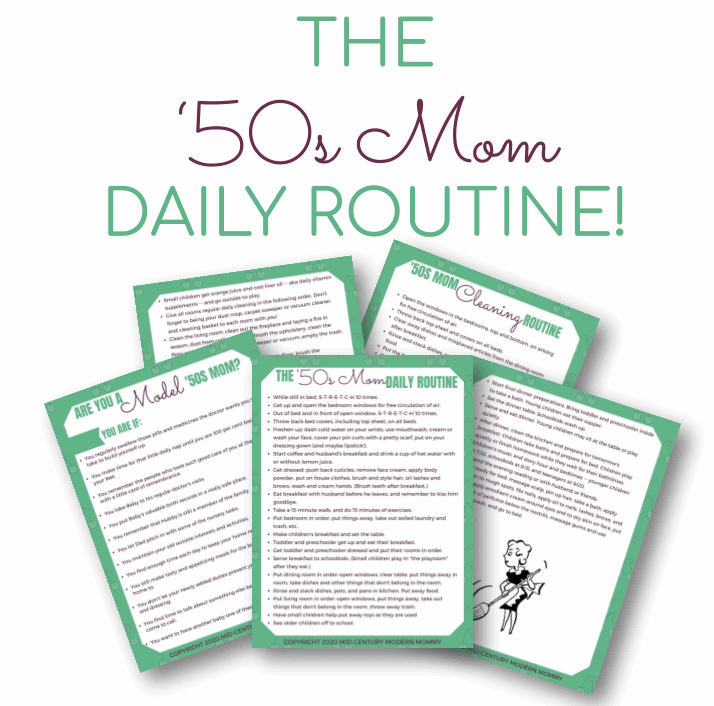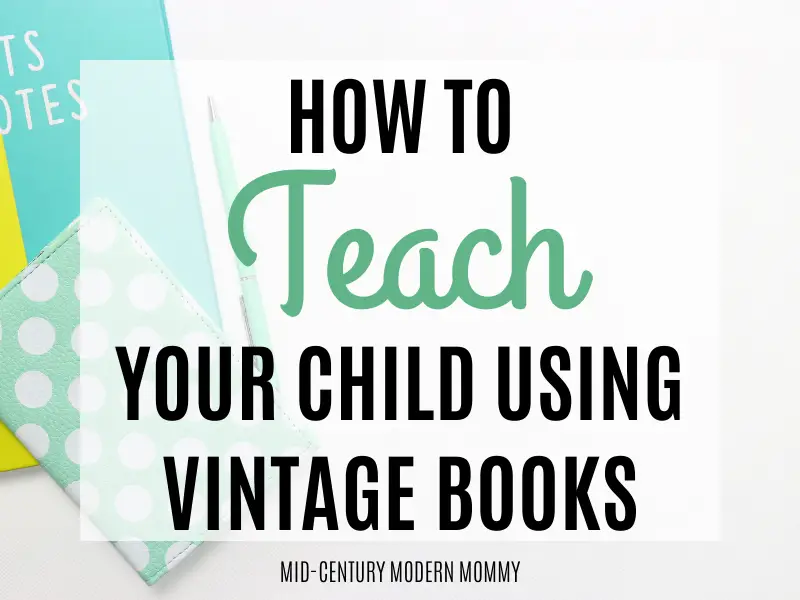This is a quick overview of how to teach your child reading, writing, and arithmetic using chalk, a slate, and a few vintage books! This also covers how to use Webster’s Speller, since you can teach any child to read with Webster’s Speller!

Get Our Mid-Century Mom Daily Routine FREE!
How to Teach Your Child to Read and Write
This post contains affiliate links. If you click a link and make a purchase, I may receive, at no additional cost to you, a small commission. Find out more on my Disclosures page, and thank you so much for your support!
You can use Webster’s Speller, the New England Primer, and the King James Bible to teach reading and writing. First, teach alphabet mastery (sounds, names, etc.) with an alphabet page, until they can tell you the name of every letter and its sound. Then, teach them to sound out the syllables and spell syllables, teaching phonics/spelling rules at the same time. Move slowly through the syllabary. Then, teach spelling by having them learn to spell orally by syllables and spelling rules. After syllables, they can start the Primer.
While working through your Primer, do daily cursive letter formation, cursive words, and finally, cursive sentences, so that by the end of the Primer, they can spell by syllables, recite the spelling rules, and write full pages of cursive. Then, they move on to reading and memorizing. After the Primer, your child can begin on the King James Bible. Start reading slowly, working up to full, polysyllabic words. For more syllable practice, use the Scottish Psalter. It is a slow process; expect it to take up to two years. By the time they are done, you can expect full pages of copywork in cursive, and reading fluently enough to tackle any book in English. I do ask for oral narration for a while, to ensure comprehension.
Around age 10, they learn to analyze and diagram sentences, and then practice diagramming sentences in English until they start Latin, Greek, and German. Diagramming sentences is the best way to learn grammar in any language. If you need a good grammar handbook to learn sentence diagramming, try Harvey’s Elementary Grammar, but Webster’s Speller has a grammar handbook at the back. Don’t teach grammar, or rewriting sentences and improving sentences and paragraphs until after they can copy full pages in cursive, read fluently, and have started math.
To improve writing, after learning to diagram sentences, begin rewriting sentences. Start by substituting words and parts of speech. Then, go on to reducing a sentence to a couple of words and rewriting it from your hints. Then, do the same thing with whole sentences. Finally, begin to work on style. Imitate beautiful language, like the language found in the King James Bible.
Other Languages
If you want to learn other languages, you will need to follow the same system. A Bible in the language you want to learn, a grammar, and a basic glossary, and you can learn any language. You DO have to diagram sentences, though.
How to Teach Your Child Math
To teach math, you can use Ray’s Arithmetic Series, which goes all the way through calculus. Start by teaching numbers, and what they represent, the same way you taught the alphabet. Teach them what each number looks like, and use counters to show the quantity of things it represents. After they know what every number looks like up to 100, begin teaching math facts. Teach arithmetic facts in addition, subtraction, multiplication, and division, up to AT LEAST 12. Then, you can use Ray’s Arithmetic, or you can teach it from your head. This is my best list for what your child needs to learn in basic math:
- Counting to twenty, then one hundred
- Counting backward from twenty
- Addition facts to 12
- Subtraction facts to 12
- Adding two, then many digit numbers
- Subtracting two, then many digit numbers
- Multiplication facts to 12
- Division facts
- Multiplication of many digit numbers
- Long division.
- Fundamental idea of fractions
- Adding and subtracting fractions
- Multiplying and dividing fractions
- Fractions as decimals
- Adding and subtracting decimals
- Multiplying and dividing decimals
- Fractions to decimals to percentages
- Negative numbers
- Adding and subtracting negative numbers
- Multiplying and dividing negative numbers
- Negative decimals, fractions, and percentages
- Money and business math
- Measuring and conversions
- Algebra
Other Things to Teach Your Child
Of course, most people want SOMEONE ELSE to take over at Algebra. Ray’s Arithmetic is excellent for self-teaching through calculus, and even continues to astronomy, surveying, and navigation!
There are other great things to add, like encouraging your child to approach science by keeping a field journal and making collections of bugs, pressed plants and flowers, or rocks. Or music, and singing psalms, hymns, or folk-songs. Or art. Drawing is a great skill. Memorize nursery rhymes, poems, or prayers. Tell Bible stories and fairy tales at bedtime. Practice copying maps until you can draw whole continents and label them from memory.
You can also use a pencil and composition book, instead of chalk and slate. You can add a dictionary, an encyclopedia, a globe. And, you can encourage jump rope or making a doll and playing house. You can teach cooking, cleaning, sewing, gardening. But most importantly, you can teach your child with almost nothing at hand. Just teach them the basics, and talk to them as they learn. The time you spend working next to your child is the most important time.
All of the books I mentioned can be found on archive.org, and you can print and bind them easily. This method works with Robinson Curriculum (you can read about how I use Robinson Curriculum here), as well. It also works as a secular method. But most importantly, if all you have is a Bible, you can still achieve literacy at the level that allowed us to write the Constitution of the United States! This is everything you need about how to teach your child the basics!





Pingback: How to Start Homeschooling - Mid-Century Modern Mommy
This really helps! Thank you!
You’re welcome! I’m working on a post that explains the checklist system and how I use it, so hopefully, that will be up soon!
I can’t wait for your checklist system post! Also, I am curious how you use Webster’s Speller? I am starting it with my 6-year-old beginning reader, but am wondering how to start it with my older fluent readers who need help with spelling. I am debating between using the Professor K Spelling or Webster’s, as we do RC as well, but I need to meep my system as minimalist as possible.
I thought I would give you a quick overview of exactly how I implement the Webster’s and Harvey’s for my kids.
I only do spelling for my kids if they are not “natural spellers.” My natural spellers read Webster’s, and just pick it up. Starting when they start on the booklist, I do an oral spelling bee every Friday among all the kids who are reading through the booklist. I use Webster’s lists, and the vocabulary words. From there, I can always tell who needs more spelling work. Right now I have two working through Webster’s, and two who just read it.
Like I said in my other comment, I use Webster’s. Prof. K’s is also excellent, but one of the learning activities is grouping them according to word families, so I use Webster’s. The student goes through a sequence for each lesson: oral spelling by syllables, copying the lesson and sorting by word families, oral spelling again, copying problem words 3x each, spelling bee against the “natural speller” siblings.
Also, we have a list of spelling rules. When they misspell a word in their writing, I mark the number of the spelling rule that applies, and they have to go back and fix it “by rule.” This is for all the students, regardless of whether they are doing copywork or composition.
For grammar, I use Harvey’s. They go through the lessons and do the exercises in the Elementary Grammar when they start writing their own content, rather than copywork. One lesson every day or two, depending on the exercises. Then, they are on their own. I mark grammar errors in their writing the same way I do spelling, and they correct “by rule.” They use Harvey’s English Grammar as a handbook, and they learn Latin and/or Greek by grammar in high school. Also English rhetoric. Prof. K’s Grammar is also a good choice. I just prefer Harvey’s.
For any students who have trouble internalizing grammar rules, they copy grammar “charts” with all the basic rules once a day until they aren’t missing the same rules over and over. Every student who has completed Harvey’s also diagrams 3-5 sentences a day, until they start Latin/Greek, and then they diagram Latin/Greek sentences everyday.
As for composition, they do copywork until about age 10, when they switch to composition. From age 10 until around the middle of high school, they free write, meaning at least a page a day on any non-fiction topic they choose. They also do critiques of every book they read on the book list. Both of these have to follow a specific format, but content is up to them. Then, in high school, they learn rhetoric and essay writing format all at once, once they already know how to generate content. That means that they refer to the templates/models for how to format their writing, but content is up to them. In high school, they learn to make their writing their own through the Ben Franklin method of rewriting, and then they study rhetoric using classical resources. And all of them go through a logic course in high school, as well.
As far as minimalist, just using Prof. K is an excellent choice. But this is how I use Webster’s and Harvey’s for my own children, who range from gifted to LD.
Oops, I just realized I already kind of asked this on another post.